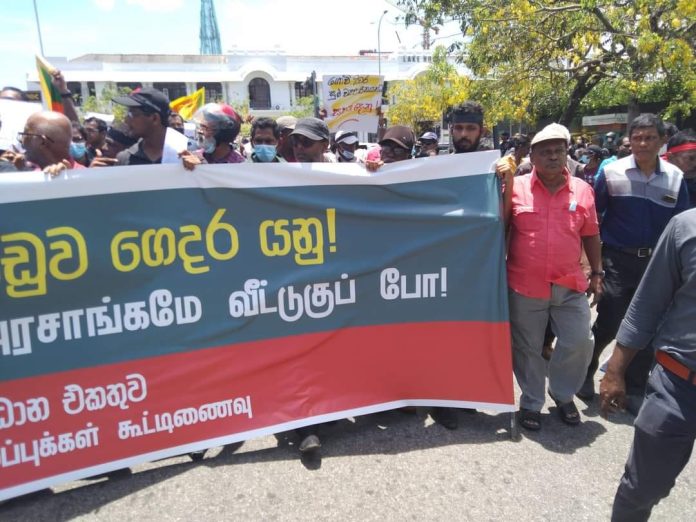Josh Asker, Socialist Party national committee
The heroic scenes of the Sri Lankan masses storming Colombo’s presidential palace, bringing an end to hated president Gotabaya Rajapaksa’s rule, will have inspired millions of workers globally who, like the Sri Lankan masses, face spiralling prices and shortages of goods.
The economic crisis fuelling the class anger of the Sri Lankan uprising was deepened further by the government’s default on its foreign debts as foreign currency reserves emptied. The default has triggered warnings throughout the capitalist press that “Sri Lanka will not be the last country to have to choose between subsidising essentials and paying creditors”.
Catalyst for uprising
The working class and poor of the so-called ‘emerging markets’, the majority of the world’s population, face a huge crisis. The world faces deep instability, and popular uprisings like that of Sri Lanka. Debt is a major catalyst.
The Economist magazine identifies 53 nations with unsustainable or vulnerable debts – the “fragile 53”. These nations include Ghana, Tunisia, Egypt and Pakistan. 60% of low-income countries, and 25% of emerging markets, are either in debt distress or at high risk of it.
Global debt continues to balloon and has reached $300 trillion. 80% of new debt last year came from emerging markets.
But with inflation rising internationally, and central banks raising interest rates, the cost of servicing that debt is increasing. Even in more developed capitalist countries this can precipitate crisis, as demonstrated by Truss and Kwarteng’s brief disastrous time in office in Britain.
Poorer nations are in even deeper water. Typically, large proportions of investment come from capitalists based in the large imperialist nations. 90% of emerging market debt is in increasingly expensive US dollars. Under threat of economic turmoil, investors are most likely to roll back their foreign spending first.
Currency crisis
A loss of confidence in a nation’s economy can see a currency’s value plummet, reducing income from exports and increasing the price of imports. For workers and the poor this means more expensive goods or a lack of them, and less income from selling produce.
In 1997, the Asian financial crisis was triggered when Thailand run out of foreign currency reserves and its currency collapsed. The crisis spread across the region, with general strikes developing and governments overthrown (see’ When the capitalist bubble burst – 25 years since the Asian financial crisis’ at socialistparty.org.uk).
25 years later, many of these nations’ governments have built up larger foreign currency reserves than in the past, and typically have a more diverse set of creditors. The proportion of debt owed to private investors and China has increased.
Although not yet the size of the US economy, the Chinese economy has grown rapidly to roughly two thirds that of the US. China’s investment overseas has grown too. The ‘Belt and Road Initiative’ is the name given to its investment portfolio based largely in developing economies.
An example is Sri Lanka’s $3.1billion Hambantota Port, financed by Chinese loans, and a cricket stadium in the same city widely regarded as a white elephant. These investments form part of a long list of infrastructure projects failing commercially, and contributing to what the Financial Times describes as China’s “first overseas debt crisis”. Belt and Road investments had reached $838 billion by the end of 2021. China itself has a growing mountain of sovereign debt, as well as increasing levels of corporate and personal debt.
The rise of Chinese capitalism, and the move away from a ‘unipolar’ world, when US capitalism was by far the most dominant force, add complications to the process of agreeing debt restructures and bailouts. As the Economist put it: “The West does not want to give aid that flows into the pockets of Chinese creditors”.
A $2.9 billion IMF bailout package for Sri Lanka has been preliminarily agreed, subject to conditions, including agreements with the nation’s creditors. Those negotiations will bring together representatives of Chinese, Indian, Japanese and US capitalism – all rivals looking to advance their own economic interests in the region and on the island.
Dealing with the debt crisis is another arena of growing inter-imperialist conflict, and the masses of the world’s poorest nations will suffer.
The inability to meet foreign debt payments, and the subsequent defaults, austerity-contingent renegotiations or bailouts, faces scores of nations. Inevitably, the economic devastation facing workers and the poor will bring popular uprisings.
Sri Lankan bailout conditions
In Sri Lanka, the mass movement grew into a force which swept aside a prime minister and president. But it has so far left the main capitalist institutions intact, and in the hands of the same capitalist class. The new president, who had previously served as prime minister numerous times, will lead a government negotiating a bailout. Its terms will inevitably demand more pain for the Sri Lankan masses.
No bailout deal will have terms which are acceptable to the workers and poor in Sri Lanka. That’s why members of the United Socialist Party in Sri Lanka, the sister party of the Socialist Party, fight for the non-payment of the debt, as a key element of their socialist programme. A government of the workers and poor in Sri Lanka, refusing to pay the foreign debts racked up by the corrupt Rajapaksa regime, and refusing to pass the cost onto ordinary people, would win huge popular support nationally and internationally for its stand.
But it would face an onslaught from the capitalist class. The threat of domestic and foreign investment fleeing the country would need to be met with capital controls. And a state monopoly of foreign trade to enable working-class democratic control of what goods are imported and exported. Nationalisation of the banks and major industry, under democratic workers’ control, would mean investment could be planned to meet the needs of ordinary people, not to serve debt payments.
Internationalism
An appeal from the masses of Sri Lanka, to the masses internationally facing a similar fate, and to the working class in their creditors’ nations – including China and India, themselves with domestic debt crises – to join in a struggle against their own capitalist classes, would undermine attempts to isolate the movement.
In Sri Lanka, as elsewhere, a socialist political programme is necessary to save the masses from ruin. What is missing in most cases is a mass working-class political party, and an organised force conscious of the need for the working class to take political and economic power into their own hands. That is what the Committee for a Workers’ International is striving to build internationally.








